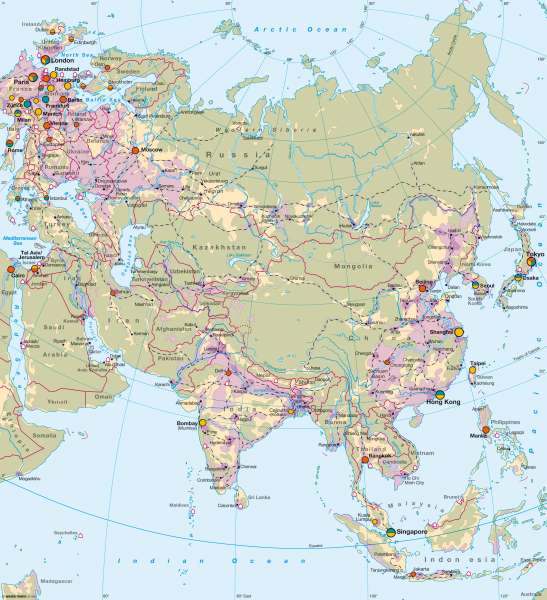Economy (overview)
Asia - Economy/Global city Singapore
978-3-14-100790-9 | Page 96 | Ill. 1

Information
Great natural scenery of Arabia, Tibet, Gobi, Central Asia and Siberia, compared with Japan, South Korea, the Great Plain, the Ganges Plain and the Java regions, belong to most densely populated and economically most intensively used cultural landscapes on the Earth. These differences, however, reflect in context only part of a natural region. The Tundra for example, is peripherally located in the dry interior continental highlands. The local natural conditions make utilisation difficult and the main focus is the exploitation of natural resources. Traditionally, these areas are sparsely populated. On the other hand, Japan and South Korea, in spite of their mountainous character with seismic activity and raw materials shortages, are of the most densely populated and economically most powerful countries on Earth.In addition, Nepal and Laos are among the countries with the lowest level of development on Earth. Emerging markets are, for example, China, Thailand, Saudi Arabia and developed countries with high or the highest level of development are Japan, South Korea, Kuwait, Israel, Singapore. They are shown in the map image as economic centres of global vibrancy and as being in prominent positions as strongly growing economies.
The "oil states" of Western Asia take up a special position. They are distinguished mainly by the dominance of oil and gas, their partially emerging and rapidly growing service economy with Dubai and their involvement in the Islamic culture of the emerging economies of South and Southeast Asia. Indonesia and Brunei in this respect take a certain intermediate position.
The People's Republic of China also holds a special position. Public and foreign investment in connection with the capture of export allowed markets to build a "socialist market economy" through economic liberalisation, while maintaining political and social power structures (which is characterised partly by an authoritarian and undemocratic nature). Social tensions are taken in parallel and this is reflected for example in severe internal migration movements.
The political and military conflicts, although not directly visible in the map image, are of great importance for the national economies. They are unsettling for Asia, causing huge economic costs and undermining co-operation. These conflicts include: Afghanistan — Iraq, Taiwan — People's Republic of China, North Korea — South Korea, India — Pakistan, Israel — Palestine / Syria and neighbouring Arab states and the Kurile conflict between Russia - Japan.
M. Felsch; Ü: C. Fleming




